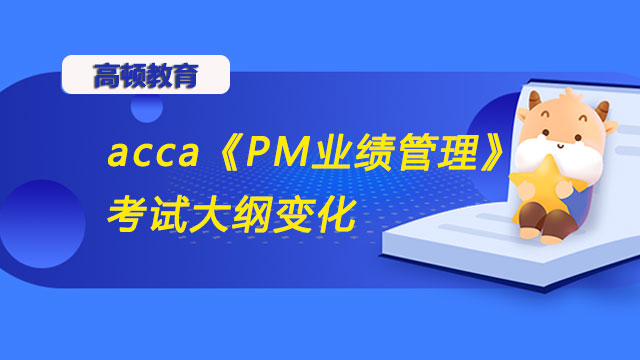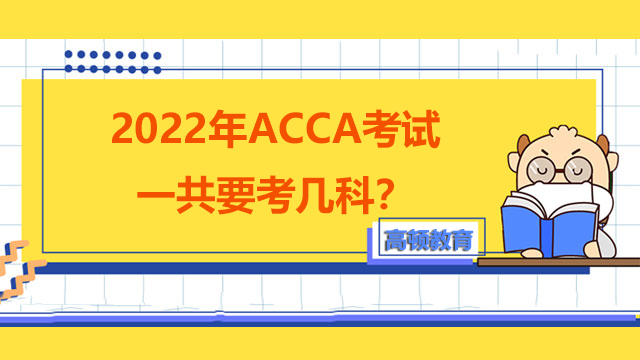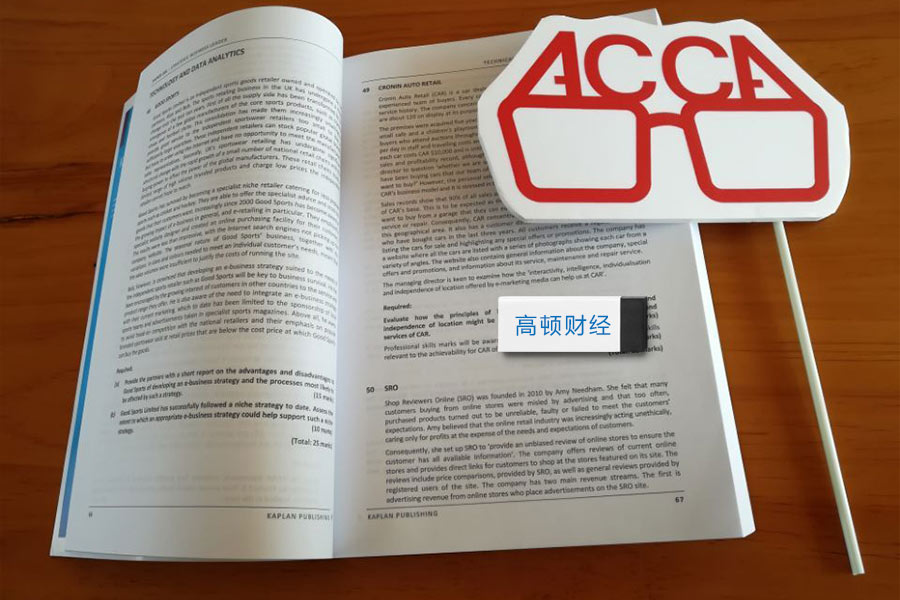2015ACCA F2 管理会计考试大纲
来源:
高顿网校
2015-03-25
? ACCA 2014 All rights reserved.
1
Management Accounting
(F2/FMA)
February 2014 to August
2015
This syllabus and study guide are designed to help
with teaching and learning and is intended to
provide detailed information on what could be
assessed in any examination session.
THE STRUCTURE OF THE SYLLABUS AND
STUDY GUIDE
Relational diagram with other papers
This diagram shows direct and indirect links
between this examination and other examinations
which precede or follow it. Some examinations are
directly underpinned by others. These links are
shown as solid line arrows. The indirect links are
shown as dotted line arrows. The relational diagram
therefore indicates where learners are expected to
have underpinning knowledge and where it would
be useful to review previous learning before
undertaking study.
Overall aim of the syllabus
This explains briefly the overall objective of the
examination and indicates in the broadest sense the
capabilities to be developed within the examination.
Main capabilities
This syllabus’s aim is broken down into several
main capabilities which divide the syllabus and
study guide into discrete sections.
Relational diagram of main capabilities
This diagram illustrates the flows and links between
the main capabilities (sections) of the syllabus and
should be used as an aid to planning teaching and
learning in a structured way.
Syllabus rationale
This is a narrative explaining how the syllabus is
structured and how the main capabilities or sections
of the syllabus are linked. The rationale also
explains in further detail what the examination
intends to assess and how.
Detailed syllabus
This shows the breakdown of the main capabilities
(sections) of the syllabus into subject areas. This is
the blueprint for the detailed study guide.
Approach to examining the syllabus
This section briefly explains the structure of the
examination and how it is assessed.
Study Guide
This is the main document that students and
learning and content providers should use as the
basis of their studies, instruction and materials
respectively.
Examinations will be based on the detail of the
study guide which comprehensively identifies what
could be assessed within any examination session.
The study guide is a precise reflection and
breakdown of the syllabus. It is divided into sections
based on the main capabilities identified in the
syllabus. These sections are divided into subject
areas which relate to the sub-capabilities included
in the detailed syllabus. Subject areas are broken
down into sub-headings which describe the detailed
outcomes that could be assessed in examinations.
These outcomes indicate what exams may require
students to demonstrate, and the broad intellectual
level at which these may need to be demonstrated
(*see intellectual levels below)。
LEVEL OF ASSESSMENTS – INTELLECTUAL
DEMAND
ACCA qualifications are designed to progressively
broaden and deepen the knowledge and skills
demonstrated by the student at a range of levels
through each qualification.
Throughout, the study guides assess both
knowledge and skills. Therefore a clear distinction is
drawn, within each subject area, between assessing
knowledge and skills and in assessing their
application within an accounting or business
context. The assessment of knowledge is denoted by
a superscriptK and the assessment of skills is
denoted by the superscriptS.
? ACCA 2014 All rights reserved.
2
VALUE OF ASSESSMENTS – GUIDED LEARNING
HOURS AND EDUCATION RECOGNITION
As a member of the International Federation of
Accountants, ACCA seeks to enhance the education
recognition of its qualification on both national and
international education frameworks, and with
educational authorities and partners globally. In
doing so, ACCA aims to ensure that its qualifications
are recognized and valued by governments,
regulatory authorities and employers across all
sectors. To this end, ACCA qualifications are
currently recognized on the education frameworks in
several countries. Please refer to your national
education framework regulator for further
information about recognition.
GUIDE TO EXAM STRUCTURE
The structure of examinations varies within and
between modules and levels.
The Foundations examinations contain 100%
compulsory questions to encourage candidates to
study across the breadth of each syllabus.
All Foundations examinations are assessed by twohour
paper based and computer based
examinations.
The pass mark for all FIA examination papers is
50%.
GUIDE TO EXAMINATION ASSESSMENT
ACCA reserves the right to examine anything
contained within any study guide within any
examination session. This includes knowledge,
techniques, principles, theories, and concepts as
specified.
For specified financial accounting, audit and tax
papers, except where indicated otherwise, ACCA
will publish examinable documents once a year to
indicate exactly what regulations and legislation
could potentially be assessed within identified
examination sessions.
For this examination regulation issued or legislation
passed on or before 30th September 2013, will be
assessed from February 2014 to August 31st 2015.
Please refer to the examinable documents for the
paper (where relevant) for further information.
Regulation issued or legislation passed in
accordance with the above dates may be
examinable even if the effective date is in the future.
The term issued or passed relates to when
regulation or legislation has been formally approved.
The term effective relates to when regulation or
legislation must be applied to entity transactions
and business practices.
The study guide offers more detailed guidance on
the depth and level at which the examinable
documents will be examined. The study guide
should therefore be read in conjunction with the
examinable documents list.
? ACCA 2014 All rights reserved.
3
Qualification structure
The qualification structure requires candidates who wish to gain the Diploma in Accounting and Business to pass
the F1/FAB, the F2/FMA and the F3/FFA examinations and successfully complete the Foundations in
Professionalism module.
Syllabus structure
The Foundations in Accountancy suite of
qualifications is designed so that a student can
progress through three discrete levels; Introductory
Certificate level, Intermediate Certificate level and
the Diploma level. Students are recommended to
enter Foundations in Accountancy at the level which
is most appropriate to their needs and abilities and
to take examinations in order, but this is not a
requirement.
F1/FAB F2/FMA F3/FFA FiP*
Diploma in
Accounting
and
Business
+ + + =
* Foundations in Professionalism
P5
F2
MA1
MA2
FMA
ACCA
FIA
P3
F5
? ACCA 2014 All rights reserved.
4
Syllabus
AIM
To develop knowledge and understanding of
management accounting techniques to support
management in planning, controlling and monitoring
performance in a variety of business context
RATIONALE
The syllabus for Paper FMA/F2, Management
Accounting, introduces candidates to elements of
management accounting which are used to make
and support decisions.
The syllabus starts by introducing the nature, the
source and purpose of cost accounting and the
costing techniques used in business which are
essential for any management accountant .
The syllabus then looks at the preparation and use
of budgeting and standard costing and variance
analysis as essential tools for planning and
controlling business costs. The syllabus concludes
with an introduction to measuring and monitoring
the performance of an organisation
MAIN CAPABILITIES
On successful completion of this paper, candidates
should be able to:
A Explain the nature, source and purpose of
management information
B Explain and apply cost accounting techniques
C Prepare budgets for planning and control
D Compare actual costs with standard costs and
analyse any variances
E Explain and apply performance measurements
and monitor business performance.
RELATIONAL DIAGRAM OF MAIN CAPABILITIES
The nature, source and purpose of management information (A)
Budgeting
(C)
Cost accounting
techniques
(B)
Performance
measurement
(E)
Standard costing
(D)
? ACCA 2014 All rights reserved.
5
DETAILED SYLLABUS
A The nature, source and purpose of
management information
1. Accounting for management
2. Sources of data
3 Cost classification
4 Presenting information
B Cost accounting techniques.
1. Accounting for material, labour and overheads
2. Absorption and marginal costing
3. Cost accounting methods
4. Alternative cost accounting principles
C Budgeting
1. Nature and purpose of budgeting
2. Statistical techniques
3. Budget preparation
4. Flexible budgets
5 Capital budgeting and discounted cash flow
6 Budgetary control and reporting
7. Behavioural aspects of budgeting
D Standard costing
1 Standard costing system
2 Variance calculations and analysis
3 Reconciliation of budgeted and actual profit
E Performance measurement
1. Performance measurement - overview
2 Performance measurement - application
3 Cost reductions and value enhancement
4. Monitoring performance and reporting
APPROACH TO EXAMINING THE SYLLABUS
The syllabus is assessed by a two hour paper-based
or computer-based examination. Questions will
assess all parts of the syllabus and will test
knowledge and some comprehension or application
of this knowledge. The examination will consist of
two sections. Section A will contain 35 two mark
objective questions. Section B will contain 3 ten
mark multi-task questions each of which will
examine Budgeting, Standard costing and
Performance measurement sections of the syllabus.
.
? ACCA 2014 All rights reserved.
6
Study Guide
A THE NATURE, SOURCE AND PURPOSE OF
MANAGEMENT INFORMATION
1. Accounting for management
a) Describe the purpose and role of cost and
management accounting within an
organisation.[k]
b) Compare and contrast financial accounting
with cost and management accounting.[k]
c) Outline the managerial processes of planning,
decision making and control.[k]
d) Explain the difference between strategic,
tactical and operational planning.[k]
e) Distinguish between data and information.[k]
f) Identify and explain the attributes of good
information.[k]
g) Explain the limitations of management
information in providing guidance for
managerial decision-making.[k]
2. Sources of data
a) Describe sources of information from within
and outside the organisation (including
government statistics, financial press,
professional or trade associations, quotations
and price list.[k]
b) Explain the uses and limitations of published
information/data (including information from
the internet) .[k]
c) Describe the impact of general economic
environment on costs/revenue.[k]
d) Explain sampling techniques (random,
systematic, stratified, multistage, cluster and
quota) .[k]
e) choose an appropriate sampling method in a
specific situation.[s]
(Note: Derivation of random samples will not
be examined)
3. Cost classification
a) Explain and illustrate production and nonproduction
costs.[k]
b) Describe the different elements of non
production costs- administrative, selling,
distribution and finance.[k]
c) Describe the different elements of production
cost- materials, labour and overheads.[k]
d) Explain the importance of the distinction
between production and non production costs
when valuing output and inventories.[k]
e) Explain and illustrate with examples
classifications used in the analysis of the
product/service costs including by function,
direct and indirect. fixed and variable, stepped
fixed and semi variable costs.[s].
f) Explain and illustrate the use of codes in
categorising transaction.[k]
g) Describe and illustrate, graphically, different
types of cost behaviour.[s]
h) Use high/low analysis to separate the fixed and
variable elements of total costs including
situations involving semi variable and stepped
fixed costs and changes in the variable cost per
unit.[s]
i) Explain the structure of linear functions and
equations.[s]
j) Explain and illustrate the concept of cost
objects, cost units and cost centres.[s].
k) Distinguish between cost, profit, investment and
revenue centres.[k].
l) Describe the differing needs for information of
cost, profit, investment and revenue centre
managers.[k]
? ACCA 2014 All rights reserved.
7
4. Presenting information
a) Prepare written reports representing
management information in suitable formats
according to purpose.[s]
b) Present information using tables, charts and
graphs (bar charts, line graphs, pie charts
and scatter graphs) .[s].
c) Interpret information (including the above
tables, charts and graphs) presented in
management reports.[s]
B COST ACCOUNTING TECHNIQUES
1. Accounting for material, labour and overheads
a) Accounting for materials
(i) Describe the different procedures and
documents necessary for the ordering,
receiving and issuing of materials from
inventory.[k]
(ii) Describe the control procedures used to
monitor physical and ‘book’ inventory and
to minimise discrepancies and losses.[k].
(iii) Interpret the entries and balances in the
material inventory account.[s].
(iv) Identify, explain and calculate the costs of
ordering and holding inventory (including
buffer inventory)[s]
(v) Calculate and interpret optimal reorder
quantities.[s]
(vi) Calculate and interpret optimal reorder
quantities when discounts apply.[s].
(vii) Produce calculations to minimise inventory
costs when inventory is gradually
replenished.[s].
(viii) Describe and apply appropriate methods
for establishing reorder levels where
demand in the lead time is constant.[s]
(ix) Calculate the value of closing inventory and
material issues using LIFO, FIFO and
average methods.[s]
b) Accounting for labour
(i) Calculate direct and indirect costs of
labour.[s]
(ii) Explain the methods used to relate input
labour costs to work done.[k]
(iii) Prepare the journal and ledger entries to
record labour cost inputs and outputs.[s]
(iv) Describe different remuneration methods:
time-based systems, piecework systems
and individual and group incentive
schemes.[k]
(v) Calculate the level, and analyse the costs
and causes of labour turnover.[s]
(vi) Explain and calculate labour efficiency,
capacity and production volume ratios.[s]
(vii) Interpret the entries in the labour
account.[s]
c) Accounting for overheads
(i) Explain the different treatment of direct and
indirect expenses.[k]
(ii) Describe the procedures involved in
determining production overhead
absorption rates.[k]
(iii) Allocate and apportion production
overheads to cost centres using an
appropriate basis.[s]
(iv) Reapportion service cost centre costs to
production cost centres (including using the
reciprocal method where service cost
centres work for each other)[s]
(v) Select, apply and discuss appropriate bases
for absorption rates.[s]
(vi) Prepare journal and ledger entries for
manufacturing overheads incurred and
absorbed.[s]
(vii) Calculate and explain the under and over
absorption of overheads.[s]
2. Absorption and marginal costing
a) Explain the importance of, and apply, the
concept of contribution.[s]
b) Demonstrate and discuss the effect of
absorption and marginal costing on inventory
valuation and profit determination.[s]
c) Calculate profit or loss under absorption and
marginal costing.[s]
d) Reconcile the profits or losses calculated under
absorption and marginal costing.[s]
e) Describe the advantages and disadvantages of
absorption and marginal costing.[k]
3. Cost accounting methods
a) Job and batch costing:
? ACCA 2014 All rights reserved.
8
(i) Describe the characteristics of job and
batch costing.[k]
(ii) Describe the situations where the use of job
or batch costing would be appropriate.[k]
(iii) Prepare cost records and accounts in job
and batch costing situations. [s]
(iv) Establish job and batch costs from given
information.[s]
b) Process costing
(i) Describe the characteristics of process
costing.[k]
(ii) Describe the situations where the use of
process costing would be appropriate.[s]
(iii) Explain the concepts of normal and
abnormal losses and abnormal gains.[k]
(iv) Calculate the cost per unit of process
outputs.[s]
(v) Prepare process accounts involving normal
and abnormal losses and abnormal gains.[s]
(vi) Calculate and explain the concept of
equivalent units.[s]
(vii) Apportion process costs between work
remaining in process and transfers out of a
process using the weighted average and
FIFO methods.[s]
(viii)Prepare process accounts in situations
where work remains incomplete.[s]
(ix) Prepare process accounts where losses and
gains are identified at different stages of the
process.[s]
(x) Distinguish between by-products and joint
products.[k]
(xi) Value by-products and joint products at the
point of separation.[s]
(xii) Prepare process accounts in situations
where by-products and/or joint products
occur. [s]
(Situations involving work-in-process and losses
in the same process are excluded)。
c) Service/operation costing
(i) Identify situations where the use of
service/operation costing is appropriate.[k]
(ii) Illustrate suitable unit cost measures that
may be used in different service/operation
situations.[s]
(iii) Carry out service cost analysis in simple
service industry situations.[s]
4 Alternative cost accounting
a) Explain activity based costing (ABC), target
costing, life cycle costing and total quality
management (TQM) as alternative cost
management techniques.[k]
b) Differentiate ABC, Target costing and life cycle
costing from the traditional costing techniques
(note: calculations are not required) .[k]
C BUDGETING
1. Nature and purpose of budgeting
a) Explain why organisations use budgeting.[k]
b) Describe the planning and control cycle in an
organisation.[k]
c) Explain the administrative procedures used in
the budgeting process.[k]
d) Describe the stages in the budgeting
process ( including sources of relevant data,
planning and agreeing draft budgets and
purpose of forecasts and how they link to
budgeting)。[k]
2. Statistical techniques
a) Explain the advantages and disadvantages of
using high low method to estimate the fixed
and variable element of costing.[k].
b) Construct scatter diagrams and lines of best
fit.[s]
c) Analysis of cost data.
(i) Explain the concept of correlation
coefficient and coefficient of
determination.[k]
(ii) Calculate and interpret correlation
coefficient and coefficient of
determination.[s]
(iii) Establish a linear function using regression
analysis and interpret the results.[s]
d) Use linear regression coefficients to make
forecasts of costs and revenues.[s]
? ACCA 2014 All rights reserved.
9
e) Adjust historical and forecast data for price
movements.[s]
f) Explain the advantages and disadvantages of
linear regression analysis.[k]
g) Describe the product life cycle and explain its
importance in forecasting.[k]
h) Explain the principles of time series analysis
(cyclical, trend, seasonal variation and
random elements) .[k]
i) Calculate moving averages.[s]
j) calculation of trend, including the use of
regression coefficients .[s]
k) Use trend and seasonal variation (additive
and multiplicative) to make budget
forecasts.[s]
l) Explain the advantages and disadvantages of
time series analysis[k]
m) Explain the purpose of index numbers [k]
n) Calculate simple index numbers for one or
more variables.[s]
o) Explain the role and features of a computer
spreadsheet system.[k]
p) Identify applications for computer
spreadsheets and their use in cost and
management accounting.[s]
3. Budget preparation
a) Explain the importance of principal budget
factor in constructing the budget’。[k]
b) Prepare sales budgets[s]
c) Prepare functional budgets (production, raw
materials usage and purchases, labour,
variable and fixed overheads) [s]
d) Prepare cash budgets[s]
e) Prepare master budgets (statement of profit or
loss and statement of financial position) [s]
f) Explain and illustrate ‘what if’ analysis and
scenario planning [s]
4. Flexible budgets
a) Explain the importance of flexible budgets in
control[k]
b) Explain the disadvantages of fixed budgets in
control[k]
c) Identify situations where fixed or flexible
budgetary control would be appropriate[s]
d) Flex a budget to a given level of volume[s]
5. Capital budgeting and discounted cash flows
a) Discuss the importance of capital investment
planning and control[k]
b) Define and distinguish between capital and
revenue expenditure[k]
c) Outline the issues to consider and the steps
involved in the preparation of a capital
expenditure budget[k]
d) Explain and illustrate the difference between
simple and compound interest, and between
nominal and effective interest rates[s]
e) Explain and illustrate compounding and
discounting[s]
f) Explain the distinction between cash flow and
profit and the relevance of cash flow to capital
investment appraisal[k]
g) Identify and evaluate relevant cash flows for
individual investment decisions.[s]
h) Explain and illustrate the net present value
(NPV) and internal rate of return (IRR)
methods of discounted cash flow[s]
i) Calculate present value using annuity and
perpetuity formulae[s]
j) Calculate NPV, IRR and payback (discounted
and non-discounted) [s]
? ACCA 2014 All rights reserved.
10
k) Interpret the results of NPV, IRR and payback
calculations of investment viability[s]
6. Budgetary control and reporting
a) Calculate simple variances between flexed
budget, fixed budget and actual sales, costs
and profits[s]
b) Discuss the relative significance of variances[k]
c) Explain potential action to eliminate variances[k]
d) Define the concept of responsibility
accounting and its significance in control[k]
e) Explain the concept of controllable and
uncontrollable costs[k]
f) Prepare control reports suitable for presentation
to management. (to include recommendation of
appropriate control action [s]
7. Behavioural aspects of budgeting
a) Explain the importance of motivation in
performance management[k]
b) Identify factors in a budgetary planning and
control system that influence motivation[s]
c) Explain the impact of targets upon motivation[k]
d) Discuss managerial incentive schemes[k]
e) Discuss the advantages and disadvantages of a
participative approach to budgeting[k]
f) Explain top down, bottom up approaches to
budgeting[k]
D STANDARD COSTING
1. Standard costing systems
a) Explain the purpose and principles
of standard costing. [k]
b) Explain and illustrate the difference between
standard, marginal and absorption costing[k]
c) Establish the standard cost per unit under
absorption and marginal costing[s]
2 Variance calculations and analysis
a) Calculate sales price and volume variance.[s]
b) Calculate materials total, price and usage
variance.[s]
c) Calculate labour total, rate and efficiency
variance.[s]
d) Calculate variable overhead total, expenditure
and efficiency variance[s]
e) Calculate fixed overhead total, expenditure
and, where appropriate, volume, capacity and
efficiency variance.[s]
f) Interpret the variances.[s]
g) Explain factors to consider before investigating
variances, explain possible causes of the
variances and recommend control action.[s]
h) Explain the interrelationships between the
variances .[k]
i) Calculate actual or standard figures where the
variances are given.[k]
3 Reconciliation of budgeted and actual profit
a) Reconcile budgeted profit with actual profit
under standard absorption costing.[s]
b) Reconcile budgeted profit or contribution with
actual profit or contribution under standard
marginal costing.[s]
E PERFORMANCE MEASUREMENT
1. Performance measurement overview
a) Discuss the purpose of mission
statements and their role in performance
measurement[k]
b) Discuss the purpose of strategic and
operational and tactical objectives and their
role in performance measurement[k]
? ACCA 2014 All rights reserved.
11
c) Discuss the impact of economic and market
conditions on performance measurement[k]
d) Explain the impact of government regulation on
performance measurement[k]
2 Performance measurement - application
a) Discuss and calculate measures of financial
performance (profitability, liquidity, activity
and gearing) and non financial measures[s]
b) Perspectives of the balanced scorecard
(i) discuss the advantages and limitations of
the balanced scorecard[k]
(ii) describe performance indicators for
financial success, customer satisfaction,
process efficiency and growth[k]
(iii) discuss critical success factors and key
performance indicators and their link to
objectives and mission statements[k]
(iv) establish critical success factors and key
performance indicators in a specific
situation[s]
c) Economy, efficiency and effectiveness
(i) explain the concepts of economy, efficiency
and effectiveness[k]
(ii) describe performance indicators for
economy, efficiency and effectiveness[k]
(iii) establish performance indicators for
economy, efficiency and effectiveness in a
specific situation[s]
(iv) discuss the meaning of each of the
efficiency, capacity and activity ratios[k]
(v) calculate the efficiency, capacity and
activity ratios in a specific situation[s]
d) Unit costs
(i) describe performance measures which
would be suitable in contract and process
costing environments[k]
e) Resource utilisation
(i) describe measures of performance
utilisation in service and manufacturing
environments[k]
(ii) establish measures of resource utilisation in
a specific situation[s]
f) Profitability
(i) calculate return on investment and residual
income[s]
(ii) explain the advantages and limitations of
return on investment and residual income[k]
g) Quality of service
(i) distinguish performance measurement
issues in service and manufacturing
industries[k]
(ii) describe performance measures appropriate
for service industries[k]
3. Cost reductions and value enhancement
a) Compare cost control and cost reduction[k]
b) Describe and evaluate cost reduction
methods[s]
c) Describe and evaluate value analysis[s]
4 Monitoring performance and reporting
a) Discuss the importance of non-financial
performance measures[k]
b) Discuss the relationship between short-term
and long-term performance[k]
c) Discuss the measurement of performance in
service industry situations[k]
d) Discuss the measurement of performance in
non-profit seeking and public sector
organisations[k]
e) Discuss measures that may be used to assess
managerial performance and the practical
problems involved[k]
f) Discuss the role of benchmarking in
performance measurement[k]
g) Produce reports highlighting key areas for
management attention and recommendations
for improvement[s]
? ACCA 2014 All rights reserved.
12
SUMMARY OF CHANGES TO F2/FMA
ACCA periodically reviews its qualification
syllabuses so that they fully meet the needs of
stakeholders including employers, students,
regulatory and advisory bodies and learning
providers. These syllabus changes are effective from
February 2014 and thereafter will be updated on 1st
September each year, from September 2015
onwards.
F2/FMA is being restructured with effect from
February 2014, to introduce longer style questions.
The new examination will consist of two sections.
Section A will contain 35 two mark objective
questions. Section B will contain 3 ten mark multitask
questions each of which will examine
Budgeting, Standard costing and Performance
measurement sections of the syllabus
There are no other changes to the syllabus.
高顿网校温馨提示: 通过ACCA考试实属不易,首先要有执着的精神,其次是不断勤奋的学习,高顿网校为大家提供ACCA题库免费做题,希望助大家一臂之力,查看详情》
| ACCA网络课程 | 课程专业名称 | 讲师 | 试听 |
 85%的人正在学习该课程 85%的人正在学习该课程 | ACCA 全维度网课体验课程 实景课堂与独立录制 覆盖所有知识点,根据学习计划推进学习进度 | 高顿名师 |  |
 70%的人正在学习该课程 70%的人正在学习该课程 | ACCA网课全科卡(8.2折) 为零基础刚开始学习ACCA的学员特别定制 | 高顿名师 |  |
精彩推荐:
版权声明:本条内容自发布之日起,有效期为一个月。凡本网站注明“来源高顿教育”或“来源高顿网校”或“来源高顿”的所有作品,均为本网站合法拥有版权的作品,未经本网站授权,任何媒体、网站、个人不得转载、链接、转帖或以其他方式使用。
经本网站合法授权的,应在授权范围内使用,且使用时必须注明“来源高顿教育”或“来源高顿网校”或“来源高顿”,并不得对作品中出现的“高顿”字样进行删减、替换等。违反上述声明者,本网站将依法追究其法律责任。
本网站的部分资料转载自互联网,均尽力标明作者和出处。本网站转载的目的在于传递更多信息,并不意味着赞同其观点或证实其描述,本网站不对其真实性负责。
如您认为本网站刊载作品涉及版权等问题,请与本网站联系(邮箱fawu@gaodun.com,电话:021-31587497),本网站核实确认后会尽快予以处理。
点一下领资料
【整理版】ACCA各科目历年真题
真题高频考点,刷题全靠这份资料
下载合集
acca全科学习思维导图
梳理核心考点,一图看懂全部章节
下载合集
2023年acca考纲解析
覆盖科目重难点,备考按照计划走
下载合集
acca备考 热门问题解答
- acca考试怎么搭配科目?
-
建议优先选择相关联的科目进行搭配报考,这样可以提高备考效率,减轻备考压力,1、F1-F4:为随时机考科目,难度较低,这里可以自行随意选择考试顺序。2、F5-F9:如果你的工作的和财务会计或者审计有关、或者你比较擅长财务和审计的话,推荐先考F7和F8。你可以选择一起考ACCA考试科目F7和F8或者先考F7(8)再考F8(7),这就要取决你一次想考几门。3、P阶段:选修科目中,建议企业首选AFM!第二部分科目进行选择,如果AA和SBR掌握学生更好,可以通过选择AAA,如果SBL掌握的好,可以自己选择APM。
- acca一共几门几年考完?
-
acca一共有15门考试科目,其中有必修科目和选修科目,考生需要考完13门科目才能拿下证书。
- acca一年考几次?
-
acca一年有4次考试,分别是3月、6月、9月和12月,分季机考科目是采取的这类四个考季的模式,而随时机考则是没有这方面的时间规定限制,可以随报随考。
- acca的含金量如何?
-
ACCA证书的含金量是比较高的,从就业、能力提升、全球认可等角度来说,都是比较有优势的证书,其含金量主要表现在以下几个方面:1、国际化,认可度高;2、岗位多,就业前景好;3、缺口大,人才激励。
严选名师 全流程服务
其他人还搜了
热门推荐
-
长春ACCA培训课程,高顿ACCA推荐吗? 2023-06-19
-
【考试重点】acca2023年9月SBL变化详解,速进了解! 2023-06-19
-
acca《PM业绩管理》考试大纲变化,2023年9月起变动情况一览! 2023-04-26
-
2023年6月acca考试哪些科目考纲有变化?赶快来看! 2023-04-25
-
ACCA2023年考试重点介绍,新手看过来! 2023-03-29
-
9月acca考试考纲变了吗?这些科目变动你要了解! 2023-03-10
-
acca考纲每次变化大吗?2023年9月起变动0%-12%! 2023-03-10
-
ACCA科目名称英文一览 2022-05-23
-
ACCA都考什么内容? 2022-05-20
-
ACCA课程内容介绍 2022-05-12
-
2022年ACCA考试一共要考几科? 2022-05-11
-
ACCA的考试内容都有什么? 2022-05-10
-
ACCA官网操作 | 如何鉴别自己是FIA还是ACCA&考试报名退考流程 2021-06-30
-
2020年最新ACCA考试大纲哪里找? 2020-03-04
-
2014年12月ACCA考试改动方向及难度变化,资阳考生必看! 2019-01-04
-
2014年12月ACCA考试改动方向及难度变化,资阳考生必看! 2019-01-04
-
2018年ACCA考试新旧考纲变化详解 2019-01-02
-
12月ACCA考试前瞻:2017年9月ACCA F7考试分析 2017-11-21
-
ACCA考试F8考试大纲变化解析 2017-04-19
-
ACCA考试F7考纲变化分析 2017-01-04
-
acca福建厦门考点i831在哪里 2016-12-19
-
拉萨有没有比较好的ACCA培训机构? 2016-06-29
-
石嘴山有没有比较好的ACCA培训机构? 2016-06-29
-
嘉峪关有没有比较好的ACCA培训机构? 2016-06-29
-
吐鲁番有没有比较好的ACCA培训机构? 2016-06-29
-
武夷山有没有比较好的ACCA培训机构? 2016-06-29
-
保山有没有比较好的ACCA培训机构? 2016-06-22
-
果洛有没有比较好的ACCA培训机构? 2016-06-22
-
临夏有没有比较好的ACCA培训机构? 2016-06-22
-
喀什有没有比较好的ACCA培训机构? 2016-06-22
 更多服务
更多服务





























